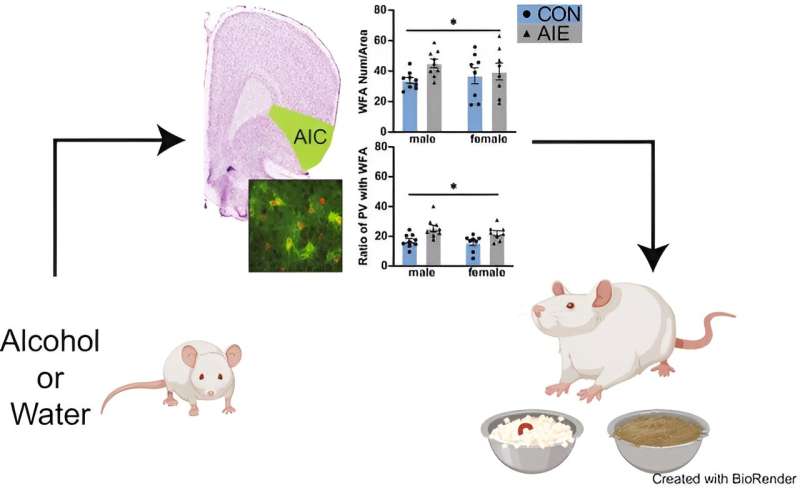This article has been reviewed according to Science X's editorial process and policies. Editors have highlighted the following attributes while ensuring the content's credibility:
fact-checked
trusted source
proofread
Teen alcohol exposure impairs behavioral flexibility and learning, shows persistent effects on brain chemistry

Rats with alcohol exposure in adolescence are less able as adults to adapt their behavior in changing circumstances, according to a study that highlights the possible brain mechanisms involved. The findings may help us better understand ways that alcohol use during the teen years can lead to long-lasting cognitive and behavioral impairments.
Adolescence is a period of rapid brain development, and commonly—in humans—for initiating alcohol use, including binge drinking. For the study published in Alcohol: Clinical & Experimental Research, investigators used rats to explore the mechanisms by which early alcohol exposure may persistently impair certain types of learning.
Previous research has shown a link between intermittent alcohol exposure in rats during adolescence and reduced behavioral flexibility as adults. These studies implicated brain regions, including the anterior insular cortex (AIC), which is involved in various emotions and behaviors.
A key element of adolescent brain development involves parvalbumin-expressing (PV+) interneurons—neurons in the central nervous system that synchronize the activity of other neurons and are likely involved in attention and cognition. PV+ neurons are surrounded by perineuronal nets (PNNs), protective lattice-like structures.
Following alcohol exposure, PNNs may be denser around PV+ neurons in relevant brain regions, potentially restricting brain plasticity and behavioral flexibility.
Researchers at the University of North Carolina at Chapel Hill worked with 38 adult male and female rats (18 alcohol-exposed and 20 non-exposed control animals) to explore these changes in brain chemistry and related behavioral deficits following adolescent alcohol exposure.
The rats were trained to dig through two types of media, which had different odors, to find a food reward. Subsequently, researchers reversed the test, pairing the reward with a different odor (reversal 1). The test was reversed again, linking the reward back to the original odor (reversal 2).
After behavioral testing, samples were taken from relevant brain regions to assess for PV+ neurons and PNNs. The researchers used statistical analysis to explore alcohol-induced changes in the number and size of PV+ neurons and associated PNNs in several brain regions and whether these—and biological sex—were linked to deficits in solving the reward tasks.
While learning the initial test, alcohol-exposed rats made fewer errors than control rats. During reversal 1, however, alcohol-exposed females made more errors than alcohol-exposed males and control females, suggesting difficulty in letting go of an outmoded strategy. During reversal 2, the alcohol-exposed rats struggled overall, performing worse than controls—with female alcohol-exposed rats making more errors than males.
The most striking brain differences were in the AIC. There, alcohol-exposed rats had smaller PV+ cells than control rats. The alcohol-exposed rats also had more PV+ neurons surrounded by PNNs and a greater number of PNNs, suggesting that alcohol exposure leads to PNN changes within the AIC.
It's possible that the AICs of the alcohol-exposed rats, especially the females, were less able to detect stimuli relevant during the attention-shifting tasks. Additional statistical analysis showed that early alcohol exposure influenced the increase in the number of PNNs and that the number of PNNs drove errors in reversal 2.
The behavioral and brain findings add to evidence of the link between adolescent alcohol use, neuronal changes, and diminished behavioral flexibility in adult rats. They also reveal that changes within the AIC are likely partly responsible. The authors identify the number of PNNs and the proportion of PV+ neurons surrounded by PNNs in the AIC as valuable targets for future studies on alcohol use, learning, and flexibility.
More information: Emily D. K. Sullivan et al, Effects of adolescent intermittent ethanol exposure on cortical perineuronal net and parvalbumin expression in adulthood mediate behavioral inflexibility, Alcohol, Clinical and Experimental Research (2024). DOI: 10.1111/acer.15395


















